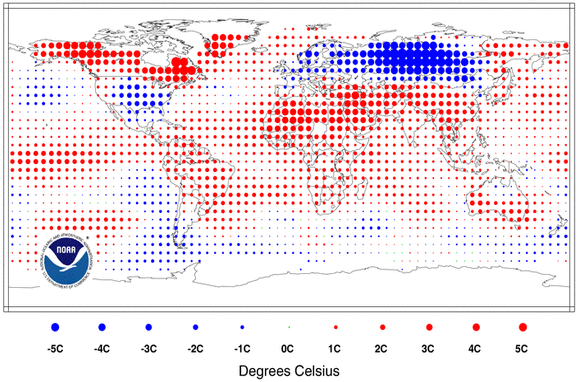 Northern hemisphere winter, that is — we’re still in a nice warm autumn down here. Before I disappear for a couple of days of hectic activity (vintage 2010 tomorrow, bottling the ‘09 on Monday), I just wanted to draw attention to a couple of articles I read over my Saturday morning toast (fine bread from the farmer’s market). The first is the review of the northern hemisphere winter by Bob Henson at UCAR: an interesting overview of how El Niño and the Arctic Oscillation combined to bring cold and snow to the US and Europe, but record breaking warmth to Canada, Greenland, North Africa and the Middle East. Henson draws on a fascinating statistical analysis of the winter by Geert Jan van Oldenborgh of the Netherlands Meteorological Institute(KNMI), putting the combination of cold, snow and warmth into the context of a changing climate.
Northern hemisphere winter, that is — we’re still in a nice warm autumn down here. Before I disappear for a couple of days of hectic activity (vintage 2010 tomorrow, bottling the ‘09 on Monday), I just wanted to draw attention to a couple of articles I read over my Saturday morning toast (fine bread from the farmer’s market). The first is the review of the northern hemisphere winter by Bob Henson at UCAR: an interesting overview of how El Niño and the Arctic Oscillation combined to bring cold and snow to the US and Europe, but record breaking warmth to Canada, Greenland, North Africa and the Middle East. Henson draws on a fascinating statistical analysis of the winter by Geert Jan van Oldenborgh of the Netherlands Meteorological Institute(KNMI), putting the combination of cold, snow and warmth into the context of a changing climate.
Van Oldenborgh assesses the the likelihood of the various temperature and snowfall anomalies in the context of an unchanging climate, and on the change that current trends indicate has already occurred. The map above left (click to see the original via KNMI) shows how often winters as cold as 2010 would be expected in the current (changing) climate: 10-50 year return periods are common, stretching out to 100-500 years in parts of Siberia. The map at right shows the warm extremes. Even in a warming climate, winter 2010 was a 10,000 year event — extremely unusual — in parts of the Middle East. Egypt’s winter, for instance, was a full 1ºC above the previous record, and 3ºC above the mean. Southern Greenland was also exceptionally warm. Compared with an unchanging climate (assuming that the probabilities for 1971-2000 still apply), the cold anomalies are less extreme because cold events were more common in the past, and the heat extremes were greater. But however you analyse the situation, the warmth experienced in Canada and the Middle East was more unusual than the US and European cold spells. It’s well worth reading van Oldenborgh’s article, even if you’d rather be eating chocolate eggs.
PS: Also noteworthy: David Appell takes a look at why current sea ice extent/areas don’t tell us the ice is “back to normal”, as some would have us believe. In the words of the old joke, sceptics are asserting “never mind the quality, feel the width.”
May all your buns be cross, and hot. Happy Easter.

